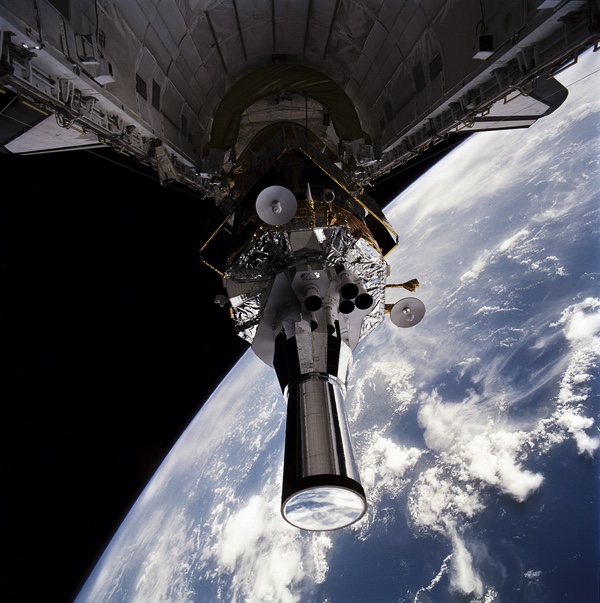The origins and evolution of the Defense Support Program (part 3): The hangar queens and DSP-1by Dwayne A. Day
|
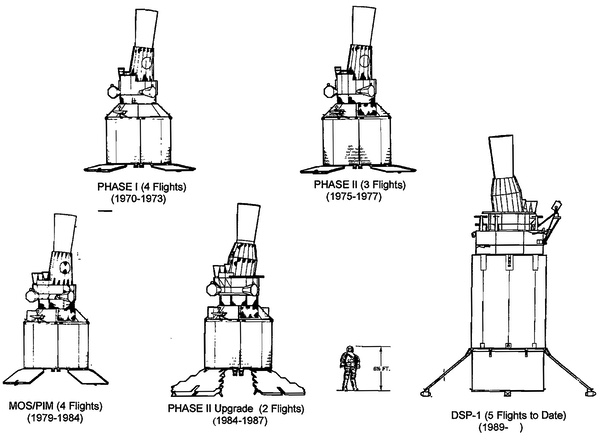 The DSP satellites underwent several major upgrades over several decades, most significantly in the late 1980s and the introduction of "DSP-1." (credit: USAF) |
Changing threats, emerging opportunities
After the initial batch of DSP launches and the Air Force gained experience operating the infrared satellites, in the mid-1970s the DSP mission began to expand, and by the early 1980s they evolved beyond mere attack alert systems to produce valuable data on both ballistic missiles and an increasing list of infrared targets. DSP satellites could be used to detect the missile fields that missiles were launched from as well as their trajectories and impact areas.[1] (See “The origins and evolution of the Defense Support Program (part 1): Infrared for missile warning”, The Space Review, August 22, 2022, and “The origins and evolution of the Defense Support Program (part 2): DSP gets an upgrade,” September 6, 2022.)
| At high speed the bombers appeared to creep across the infrared sensors on DSP satellites and their slow speed compared to ballistic missiles and satellites led to them being designated “Slow Walker” targets. |
One of the original reasons DSP had been developed was to warn of Soviet Fractional Orbital Bombardment System (FOBS) attack. However, by the late 1970s, the Soviets had deployed only 18 of the SS-9 FOBS, all at the sprawling Soviet launch complex at Baikonur, in Kazakhstan—then referred to as Tyuratam by the US intelligence community.[2] Some observers even went so far as to attribute the halt in the deployment of FOBS to DSP’s capabilities, although other reasons, including FOBS’ destabilizing nature, also deserve credit.[3]
There were changes as well to various American ground-based warning systems. The unreliable and limited FSS-7 submarine-launched ballistic missile (SLBM) radars based around the U.S. coast were gradually updated with a phased array system known as Pave Paws. Likewise, the Ballistic Missile Early Warning System (BMEWS) sites were also upgraded to include phased array radars. But while the FOBS threat faded, other threats, including tactical ones, emerged and DSP proved to offer some solution to them.
By 1974 and 1975, several studies had shown that the DSP satellite was also useful at detecting tactical ballistic missiles—something that came as a bit of a surprise to those operating the satellites. In addition, DSP satellites also provided useful intelligence data on new Soviet missiles. By measuring rocket burn times and trajectories, this data could be used in conjunction with other data such as intercepted signals from the rockets to assess new ICBM developments.
As Soviet Backfire bombers entered service in the 1970s, the DSP satellites began spotting them when they used their afterburners. The Backfire was used both as a strategic bomber and in an anti-shipping role. They were considered major threats to American aircraft carriers. But at high speed they appeared to creep across the infrared sensors on DSP satellites and their slow speed compared to ballistic missiles and satellites led to them being designated “Slow Walker” targets. They were of great interest to the US Navy, which began exploring how to best use DSP data to protect ships at sea from Soviet attack.
In the early 1980s, the first vessels of the Soviet Union’s Slava class with their SS-N-12 Sandbox missiles were entering service, designed to attack American aircraft carrier battlegroups. (The Moskva, sunk by Ukraine in the Black Sea in 2022, was a Slava-class cruiser.) They were also joined at sea by the first vessels of the Kirov battlecruiser and Oscar submarine classes. Both the Kirov and the Oscars carried a new, massive anti-ship missile, the aptly named SS-N-19 Shipwreck, which shared some commonality with the earlier Sandbox missile. The Shipwreck could carry either a nuclear or conventional warhead and was powered by a turbojet giving it a range of 555 kilometers. It was over ten meters long and had a top speed of Mach 2.5.[4]
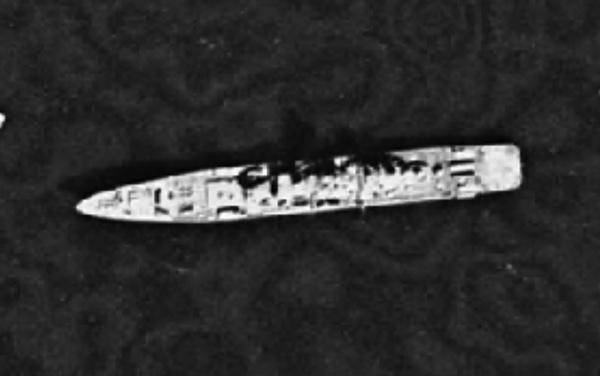 The Soviet nuclear-powered guided missile cruiser Kirov was photographed by an American reconnaissance satellite in 1980. Kirov was equipped with powerful anti-ship missiles for sinking American aircraft carriers. DSP was capable of spotting these missiles in flight, targets that were classified as “slow walkers” because they moved slower than ballistic missiles across the satellite’s field of view. (credit: Harry Stranger) |
The vessels could receive the locations of US aircraft carriers from RORSAT and EORSAT satellites and feed this information into the guidance systems of the missiles, which then burst out of the launch tubes on the deck of the ship, or from under the ocean, with the aid of two booster rockets. These booster rockets produced infrared signatures visible from space, but only for a short period of time. Like the Backfire bombers, such targets were also labeled “Slow Walker.” The new sensors on satellites DSP 5R and 6R could detect them.[5] By designating a special Area Of Interest (AOI) on the Earth and increasing the sensor’s sensitivity for this area, DSP could provide advance warning of an attack against US or NATO ships. The Oscar submarine was particularly worrisome because it was very difficult to track and the launch of a dozen missiles might be the first indication a US Navy admiral had that his fleet had been targeted.
Other Slow Walker targets included the SS-N-12 on the Slava cruisers and the Kiev-class aircraft-carrying cruisers, the much-feared AS-4 Kitchen anti-ship missile fired by the Backfire bomber, and the SS-N-22 Sunburn missile also deployed during the 1980s. The AS-4 performed a rapid climb to altitude soon after launch which made it visible from space. The Sunburn, although not as massive as the Shipwreck, flew at speeds greater than Mach 2.5 and it covered its maximum range in under three minutes, meaning that there was little advance warning of its approach and almost no time to defend against it. Its small size made it difficult to detect on radar as it skimmed over the waves. Detection, classification, and notification of the potential target were vital in the short period of time available.
A US Navy collection team first visited the DSP’s Overseas Ground Station in Nurrungar, Australia, in 1983, and a formal Operational Requirements Document was drafted in 1984 and rewritten in the late ’80s. The initial warning was apparently delivered by voice through a communications link from NORAD using an AFSATCOM channel. Later the Navy began a program to develop a direct receiving capability on command ships and known as Radiant Ivory. The overall effort was known as the Slow Walker Reporting System (SWRS).[6] The capability was almost certainly integrated with other Navy systems for detecting Soviet ships by satellite. (See “Shipkillers: from satellite to shooter at sea,” The Space Review, June 28, 2021, and “Spybirds: POPPY 8 and the dawn of satellite ocean surveillance,” The Space Review, May 10, 2021.)
By the early 1980s a new threat had also emerged: SS-20 Saber mobile land-based missiles deployed in the Western USSR. The SS-20 carried three warheads and had a range of 5,000 kilometers. Because it was launched from a wheeled vehicle, detecting it was particularly difficult since it could simply fade into the forest. In 1984, more SS-20 bases were built than in any other year.
This growing threat prompted the Pentagon to take action. After a meeting of the Joint Chiefs of Staff (JCS) in March 1984, the Air Force moved the Atlantic DSP satellite, at 70 degrees west, eastward to a position at 37 degrees west. The satellite was possibly turned over to the control of the new European ground facility which had become operational in Kapaun, Germany, in 1982. By the end of the year, the JCS decided to leave the satellite at this position.
| By the 1980s, DSP had evolved from a system primarily designed to detect strategic ballistic missiles to a system that could provide detection and warning of many other kinds of threats, including those to tactical forces. |
The satellites also detected the flash of meteoroids exploding in the atmosphere. Although military users considered this data of no utility, in later years, civilian scientists sought access to the data for understanding the risk of asteroids impacting the Earth, a subject that became much more prescient when a meteorite exploded over the Russian city of Chelyabinsk in 2013, causing many injuries.[7]
DSP did not operate alone. Another infrared detection system mounted on classified satellites in highly elliptical orbits also provided data. That system, known by the general designation of “DSP-Augmentation,” provided overlapping coverage and different viewing angles than DSP satellites high over the Equator. The multiple data sources were integrated on the ground to produce a better understanding of the targets, but there is almost no information on DSP-A other than its existence.
By the 1980s, DSP had evolved from a system primarily designed to detect strategic ballistic missiles to a system that could provide detection and warning of many other kinds of threats, including those to tactical forces. Soon, that capability would become highly valuable, and famous.
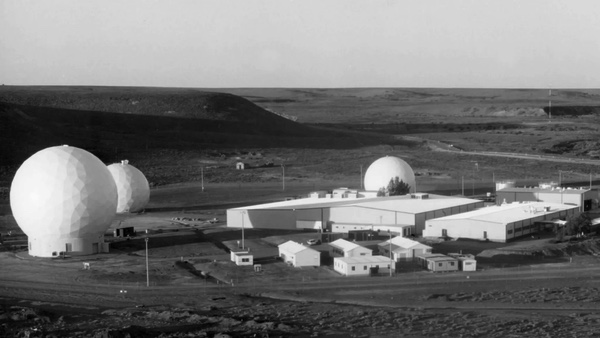 There were two DSP ground stations in the early years of the program. One was located outside of Denver, Colorado, and the other was at Nurrungar in Australia. The Nurrungar station was politically sensitive, and US officials worried that a change in government could result in its closure. (credit: Aviation Week & Space Technology) |
Increasing survivability
As DSP became an important military asset in the 1970s, Air Force leaders were aware of its vulnerabilities. Early efforts focused on reducing the satellites’ vulnerability to radiation as well as possible blinding by lasers. But perhaps the most obvious vulnerabilities were the two large ground stations: the Continental Ground Station (CGS), located north of Denver, Colorado, at Buckley Air National Guard Base, and the Overseas Ground Station, located in a remote location in Australia known as Nurrungar. The Colorado ground station in particular had large satellite domes that were only a few hundred meters from public roads and small businesses. A Soviet Spetznaz special forces team with a rocket launcher in the back of a pickup truck could shoot at them from across the street.
By the mid-1970s, the Air Force began initial development of the Simplified Processing Station, or SPS, a smaller, transportable DSP ground station. Early Air Force plans called for deployment of up to five SPS ground stations in various locations, including the continental United States and overseas. However, over time the SPS grew in size and cost, and the Air Force had difficulty gaining support for it. Eventually only one SPS was built.
By 1981, the SPS was set up for testing at the decommissioned Cornhusker Army Ammunition Plant in Nebraska. The system was designed to be transportable within 30 days, and after an operational testing and evaluation phase it became the Small CONUS Ground Station. In 1982 the station was packed up and then deployed to Kapaun, Germany, where it became known as the European Ground Station (EGS). The Cornhusker site was closed.[8]
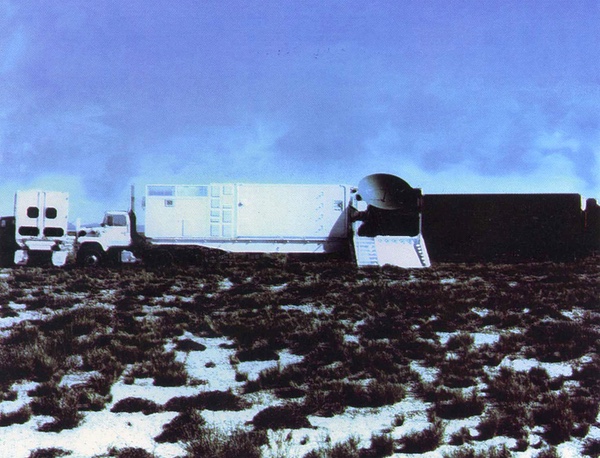 The potential vulnerability of the DSP ground stations led the Air Force to seek new solutions. One was the Mobile Ground Terminal that was packed into several road and air-mobile trailers. In time of crisis, the MGTs could be dispersed to remote locations in the American southwest. During Operation Desert Shield in 1990, MGTs were transported to the Middle East and used to warn of Scud missile launches. (credit: USAF) |
Instead of deploying multiple fixed SPS, which would still be vulnerable to attack, the Air Force began development of an even smaller system known as the Mobile Ground Terminal (MGT). The MGTs would be carried on a fleet of trucks to be kept at a base in the American southwest and intended to head out into the desert in times of heightened international tension. The trucks would drive to obscure locations where their crews could set up satellite antennas to communicate with Defense Support Program (DSP) missile warning satellites in case the balloon went up. Unlike the post-apocalyptic vehicles of Mad Max movies, they did not look that different from commercial trucks on American highways. But they were a vital part of a suite of upgrades and improvements made to the DSP satellites and support infrastructure in the second decade of their existence. The Air Force sought to procure five MGTs. The first MGTs arrived at Holloman Air Force Base near Alamogordo, New Mexico, in 1984. From there they could also be loaded into aircraft to be transported around the world.[9]
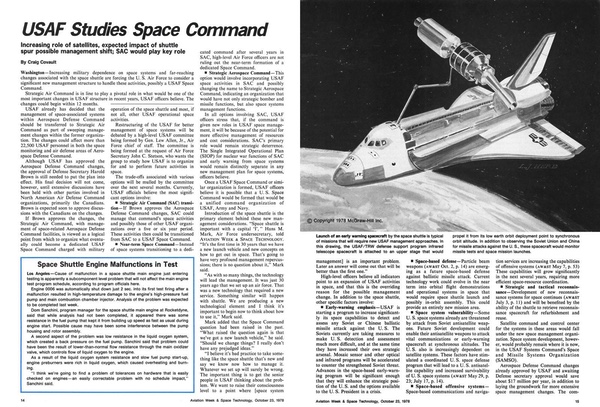 In the 1970s, the Air Force expected to eventually launch all of its payloads aboard the space shuttle. This artist impression shows a DSP satellite carried by the shuttle. Although generally accurate, the telescope barrel is too long. (credit: Aviation Week & Space Technology) |
Hangar queens
DSP satellites 5 and 6 had remained in storage for many years, undergoing periodic upgrades while their newer sister spacecraft had been lofted into orbit soon after leaving the production facility. But by the early 1980s it was not clear which launch vehicle would actually carry them into orbit. Originally, the satellites were to be made compatible with the Titan 34D/IUS configuration and the shuttle/IUS. But the Inertial Upper Stage program had fallen behind schedule and the Air Force decided to procure additional Transtages for use with the Titan 34D to serve as backup. This decreased the likelihood that the satellites would be grounded awaiting a launch, but meant that two satellites would each have to be made compatible with three launch vehicles—an expensive proposition. In early 1982, Space and Missile Systems Division (formerly SAMSO) appealed to Air Force headquarters for relief. In May, USAF headquarters directed that they drop the shuttle requirement and make satellite 5 compatible with the Titan 34D/Transtage and 6 with the Titan 34D/IUS.[10]
A new infrared sensor was to act as the prototype for those mounted on satellites 14 and on, which would have greater lifetimes and capabilities. The sensor had a significantly increased number of infrared detectors, which gave the satellites the ability to not only detect the missile field that an ICBM had been launched from, but the specific silo it had come out of. This meant that the satellites could now be used not only to warn of attack, but to plan America’s nuclear counterattack by identifying empty Soviet silos as opposed to those still containing ICBMs.
| DSP satellites 5 and 6 had remained in storage for many years, undergoing periodic upgrades while their newer sister spacecraft had been lofted into orbit soon after leaving the production facility. But by the early 1980s it was not clear which launch vehicle would actually carry them into orbit. |
The new infrared sensor not only had increased capabilities, but also had a new cooling system designed to increase its lifetime, something that would prove amazingly successful. It also had two optical sections, with a “corrector lens” mounted inside the sunshade, apparently to protect against attempts to blind the satellites with lasers on the ground. In addition to the sensor and internal modifications to the satellites, more solar cells had to be added. The early satellites in the program had solar cells on paddles, surrounding the satellite body, and covering the conical section at the base of the sensor. But as the satellites evolved, more electrical boxes, including the platform for Advanced RADEC I nuclear burst detectors, were added to the conical section, decreasing the number of solar cells. This was offset by adding more solar cells to the body and the paddles. But the increased power use of the new sensor demanded even more cells and as a result new "notched" solar paddles were fitted to the satellites, increasing their area. Power generation for 5R and 6R was 890 watts.[11]
By April 1984, Flights 6 and 7, serving as backups, had mis-identified several missile launches. In May of 1984, satellite F-9 suffered serious anomalies. F-9 had been troubled its entire lifetime, particularly suffering problems with its sensor. Unlike the earlier problems with the sensor, these problems included a fuel leak as well as problems with the KGP-29A encryption unit.[12]
Air Force Space Command (which absorbed ADCOM, among other organizations) requested that the Joint Chiefs of Staff approve a new DSP launch. Approval was given and the launch was scheduled for December 15, 1984. This was satellite 6R. Its launch slipped a week due to problems with the booster and it was launched on December 22, 1984—a decade after it was built. The satellite was launched atop Titan 34D-13 from Florida, and designated Flight 12 on orbit.
Flight 12, unlike its sister satellite 5R, had an additional capability referred to as “second color.” This was a set of mercury cadmium telluride detectors capable of detecting emissions in the 4.3-micron band. They were apparently attached to the end of the focal plane array to give the sensor increased capability to detect above-the-horizon targets—mainly the second stages of ICBMs firing above the North Pole. To fully exploit this capability, F-12 would have to be located at the Indian Ocean spot so it could view the hot exhaust of the ICBMs tail on, but this is not where it was initially placed.
F-12's new capabilities led to a more extensive period of testing. Whereas F-11 had been declared operational in less than two weeks, F-12 took five months, becoming operational in May 1985. While it was being tested, both F-6 and F-7 had been lost. F-7 had lost Earth lock and began drifting off station, uncontrolled. F-6 suffered the same problem but was boosted out of geosynchronous orbit in early March after end-of-life testing. Sometime during its testing, F-12 apparently took a new spot over the Pacific, moving from 134 degrees to approximately 152 degrees west. Also, as previously noted, F-10 over the Atlantic had shifted to a new position at 37 degrees west over the Atlantic, apparently under the control of the new ground station at Kapaun, West Germany. This meant that the operational satellites now occupied two new spots and one old spot: 153 degrees west, 37 degrees west, and 69 degrees east.
As F-12 became operational at the new Pacific spot, F-11 was shifted to take over the Indian Ocean spot from the troublesome F-9, which was placed in reserve as the Eastern Hemisphere Limited Reserve Satellite at 75 degrees east. F-8 continued to serve in this backup role for the Western Hemisphere.
By the time F-12 was operational, the constellation was in decent shape, with problems only with the backup F-8. But the sensors for F-10 and the older satellites were already exceeding design life, so the Joint Chiefs ordered that satellite 5R be launched in late September 1985. The satellite was shipped to the Cape in August and mated to its booster in preparation for launch. These plans were to crash headlong into a series of calamities that befell the US military and civilian space programs.
Dark days for the American space program
On August 28, 1985, a Titan 34D flying out of Vandenberg in California and reportedly carrying the seventh KH-11 reconnaissance satellite failed to reach orbit. This failure prompted a delay in the planned DSP launch from Florida. In January 1986, the space shuttle Challenger exploded, throwing future military space launches aboard the shuttle into doubt. Then, on April 18, 1986, a spectacular explosion of a Titan 34D at Vandenberg destroyed the last of the KH-9 Hexagon reconnaissance satellites, creating a toxic cloud and raining pieces of the classified satellite around the launch site. Because DSP satellite 5R would launch on the same kind of rocket that had failed in August 1985 and April 1986, the Air Force was unwilling to launch it until the problems had been fully identified. By June 1986, satellite 5R was removed from its launch vehicle and sent back to TRW, the manufacturer. The American military space program was firmly grounded.
The on-orbit DSP constellation continued to function, although some of the satellites were showing their age. F-8, the backup, had lost its star sensors and suffered problems with its reaction wheel. It was written off by early August 1986. F-9 was running low on propulsion fuel. The active satellites had lost some backup capabilities, meaning that they could fail completely with the loss of a single component. F-11 was the most worrisome of these.
Even before the April Titan 34D explosion, Air Force Space Command was concerned about booster availability. Satellite 14 was scheduled for a launch aboard the shuttle in May 1987, and if 5R were lost during launch, they would be in major trouble. In addition, the Air Force had begun procurement of the Complementary Expendable Launch Vehicle to pick up some of the slack from shuttle delays. But the combination of all the failures led to a “bow wave” effect as all of the military’s payloads began to slip further and further back and many had to be reconfigured for launch on the CELV, later renamed the Titan IV. Military and intelligence satellites began to stack up in clean rooms around the country.
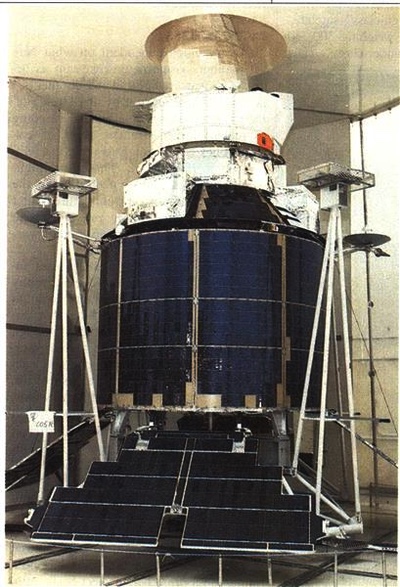 The 13th DSP satellite launched was actually the fifth one built and had spent a decade in storage until it was upgraded with a new sensor. (credit: USAF) |
By 1987, the shuttle was still far from returning to operation, but a contingency plan had been produced to draft the venerable F-7 satellite back into service if need be. Fortunately, the situation was resolved. While the DSP users had been on pins and needles this entire time, the intelligence community had been even more anxious, as the April Titan failure left the United States with only one reconnaissance satellite on orbit. In October 1987, it was joined by another KH-11 imaging satellite. DSP satellite 5R was shipped to the Cape and mated to its booster. On November 28 it was launched into orbit atop Titan 34D-8. It was named Flight 13, finally reaching orbit almost fourteen years after it had first been delivered to the Air Force.
| Somewhat ironically, the new satellite type was also known as “DSP-1,” although it was the compromise solution resulting from the rejection of a more advanced “DSP II” proposal earlier in the decade. |
Like its sister, Flight 13 took longer than expected to reach operational status, not achieving this until March 1988, when it relieved F-10 as the Atlantic satellite. F-10 moved to the Pacific slot, replacing F-12. F-12 moved to the Eastern slot, replacing F-11, so that F-12 was now finally in its originally intended location where its additional capabilities would be able to spot the second stages of ICBMs when they fired above the horizon. F-11 was then shifted to a new position at approximately 10 degrees east and coming under the command of the ground control facility at Nurrungar in Australia. F-9 suffered a major failure in April 1988 and was boosted out of geosynchronous orbit. F-7 continued in its backup role.
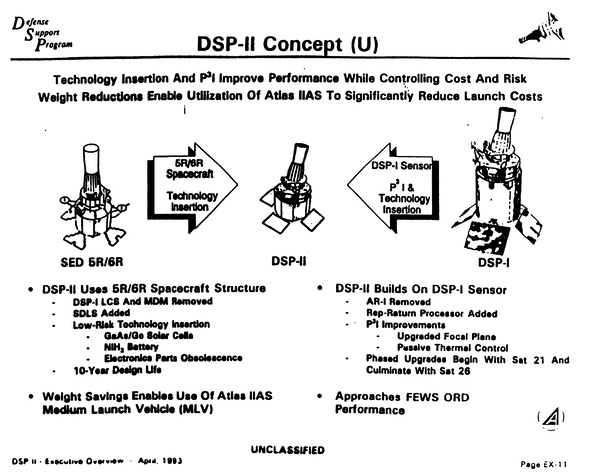 Concern about the costs of several military space programs led in the early 1990s to a proposal for a “DSP II” that would build upon recent technology upgrades but packaged in a smaller spacecraft that could be launched on an Atlas rocket instead of the expensive Titan IV. This proposal was rejected, and the “DSP-1” design remained standard for the next decade. (credit: USAF) |
DSP-1/Block 14
Both F-10 and F-11 were predicted to fail sometime during 1989, so Air Force Space Command made the decision to launch the first of the newer satellites, number 14, which was originally supposed to fly in 1987. This new satellite was substantially larger than its predecessors and was the result of a DoD decision early in the 1980s to introduce major improvements to the DSP satellite design rather than to develop an entirely new satellite. A few years later, the beginning of the Strategic Defense Initiative (SDI)—popularly known as “Star Wars”—complicated the situation, because SDI would require far more advanced missile warning and tracking capabilities than DSP could provide.
For complicated reasons, satellite 14 was equipped with sensor 17 (satellite 17 received sensor 14.) Satellite 14 would fly atop the first of the new Titan IV rockets, newly designated as the primary booster for the DSP. The launch was originally scheduled for March 1989, but slipped. On June 14, the satellite roared aloft atop Titan IV K-1 and began its lengthy checkout period as the first of a new, and final, class of DSP satellites known as "Block 14." Somewhat ironically, the new satellite type was also known as “DSP-1,” although it was the compromise solution resulting from the rejection of a more advanced “DSP II” proposal earlier in the decade.
Each DSP-1 satellite weighed 2,386 kilograms, had solar arrays providing at least 1,290 watts of power for the required 1,225 watts for the sensor and other instruments. They were intended to have a three-year design life with a five-year goal. Although operating in geosynchronous orbit, these satellites also had a Molniya orbit capability like their predecessors. The satellites also had improved hardening to JCS Level-2 for electromagnetic pulse. The sensors had the second color capability as flown in satellite F-12. The Block 14s also had a new subsystem known as Mission Data Message rebroadcast system (MDM), whose purpose is unclear. MDM apparently didn't initially work as planned.
In addition, the satellites carried two Department of Energy sensors to measure electric charges and radiation in the vicinity of the spacecraft. Known as the Magnetospheric Plasma Analyzer and the Synchronous Orbit Particle Analyzer, these instruments helped Los Alamos scientists to determine that the Earth's plasmapause is not simply teardrop shaped but irregular and wavy.[13] The sensors were newer versions of sensors known as Charged Particle Analyzers, which flew on DSP satellites apparently beginning with the Phase II satellites. Their results have been published in several physics papers, where the DSPs were usually referred to as the “Los Alamos Satellites.”[14]
The Laser Crosslink System
Since the beginning of the DSP program, the Overseas Ground Station in Australia had been a major political vulnerability. In return for operating a ground station on Australian territory, the Australians gained some access to the satellite’s early warning data. But there was always the possibility that a new government would end the agreement, or seek to renegotiate its terms. Throughout the 1960s and 1970s, the United States military and intelligence communities had lost access to important sites around the world in less-stable countries such as Pakistan, Ethiopia, Iran, and Turkey, and although Australia’s government was considered friendly, there was opposition within the country to becoming too closely aligned with the United States. (Canada also received DSP data through its association with NORAD, and other countries such as Israel have also received data, particularly during the Gulf War, through the use of a truck-mounted Mobile Ground Terminal.) The political situation prompted Air Force officials to seek a way to eliminate reliance upon the OGS, and an obvious solution was to send DSP data and commands through another satellite in orbit.
Block 14 satellites starting with number 15 were intended to be equipped with a Laser Crosslink Subsystem (LCS), which was designed to provide secure satellite-to-satellite communication, allowing launch detection information to be passed to another DSP satellite within view of the continental United States and thus eliminating the need to route information through a ground station, up to a DSCS communication satellite, and then down to the United States. The primary contractor for the LCS was McDonnell Douglas, with Kodak supplying the optics.
But due to severe design problems, LCS was not available for the first three DSP-1 flights. At least two production LCS systems were delivered to TRW, but the second system failed and was returned to the manufacturer.[15] Ultimately LCS was canceled after $400 million had been poured down what to some people had begun to seem like a bottomless hole. Tentative plans were to deploy LCS on DSP-17 in 1994, and 15 and 16 were supposed to fly with 91 kilograms of ballast.[16] DSP-14 flew with other sensors/systems in place of LCS, including a Strategic Defense Initiative “background and target data sensor” known as UVE for Ultra-Violet Experiment and often referred to as “third color”.[17] It also included two other sensors of unknown characteristics.[18]
The satellites had two high-gain antennas for communications channels known as Link-1 and Link-2. The spacecraft also had eight encrypted communications links used to relay and downlink satellite data and command instruction along with their associated receivers, transmitters and antennas. They utilized KG-57 decryption units to protect the satellites from being taken over by a hostile ground facility.[19]
After the LCS system was canceled, a Lockheed/McDonnell Douglas team began competing a laser-link system against a TRW developed extremely high frequency crosslink system for the DSP’s successor.[20] But this program was also canceled when the crosslink requirement for the DSP’s successor was eliminated to save weight and cost.
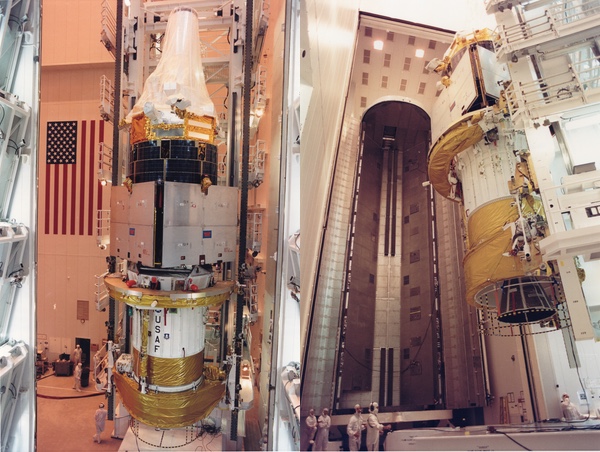 The 16th DSP satellite during installation aboard the shuttle Atlantis in 1991. (credit: NASA) |
DSP Becomes Famous
After launch, satellite F-14 took up position over the Pacific, replacing F-10, which was presumably relegated to a backup status. The satellite was apparently originally slated to go to the Atlantic, where its lack of a crosslink would not have been a problem, but troubles with F-10 had led to the decision to send it to the Pacific. F-14 took a long time to declare operational, in part because no formal requirements for operability had been established. Sometime after reaching orbit it began to experience vibrations in its reaction wheel, which was bigger and rotated at higher rpm than the reaction wheels on previous satellites to negate the satellite’s greater mass. The solution was to decrease the rotation speed of the wheel and monitor it closely.
On November 13, 1990, another satellite was launched atop Titan IV K-6. Once on-orbit, it was named F-15 and took the European spot at 10 degrees east, replacing F-11. F-11 was apparently assigned to a new backup slot at 110 degrees east, over the East Indian Ocean and probably under control of the ground station at Buckley Air National Guard Base in Colorado.
| DSPs were heralded as a great asset during the war, since they provided the first warnings of attacks on Israel and Saudi Arabia. But there was also some public criticism of their limitations for detecting targets such as tactical ballistic missiles. |
In summer 1990, the armed forces of Iraq invaded neighboring Kuwait, and the United States led the buildup of forces in the Persian Gulf to prepare to attack Saddam Hussein’s military. Iraq possessed numerous Scud medium-range ballistic missiles that could be fired at Saudi Arabia as well as Israel—by attacking Israel, Hussein hoped to fracture the coalition of Arab nations that opposed his invasion. It was clear to the United States military that finding and negating the Scud missiles would be a major effort, and detecting their launches would be extremely important for defending against them. In early 1991, the Persian Gulf War started.
During the Persian Gulf War, satellites F-12, F-13, and F-15 were the primary satellites over the theater of operations. F-15 was still undergoing checkout and was not considered operational at the time. One of these satellites was moved to provide better coverage. This was probably F-13 over the Atlantic Ocean, which was most likely moved east. If it was not already, it was apparently placed under control of the Kapaun ground station at this time. Kapaun had now been renamed the European Ground Station (EGS). During the Gulf War the sensitivity of the sensors was increased to detect the cooler Scud missiles. This posed the risk of increasing the number of false alarms—a problem which happened early in the war but was corrected by its end. DSPs were heralded as a great asset during the war, since they provided the first warnings of attacks on Israel and Saudi Arabia. But there was also some public criticism of their limitations for detecting targets such as tactical ballistic missiles.[21]
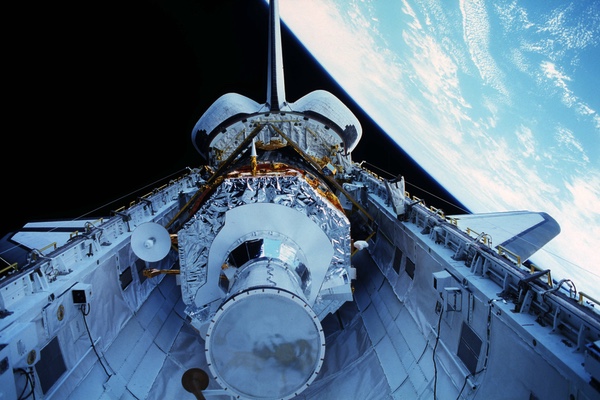 The 16th DSP satellite was carried into orbit in late 1991 aboard the shuttle Atlantis. (credit: NASA) |
On November 28, 1991, another satellite was launched, this time aboard the space shuttle Atlantis during STS-44. Nicknamed by the crew “DSP Liberty”, the satellite was formally named Flight 16 upon release from the shuttle bay.[22] It is most likely that this satellite took over the East spot at 69 degrees east. It relieved F-12, which headed to the East Indian spot. The satellite previously holding this position, the old F-11, may have suffered problems that required it to be moved east to approximately 150 degrees east in the middle of 1991.[23] It was discarded when F-12 took the operational slot at 110 degrees east. Both the first and second DSP-1 satellites suffered from blown fuses in the thermal control systems for their focal plane arrays. This problem was fixed on satellite 16, but it meant that F-14 and 15 could not see certain dimmer targets.[24]
By the end of 1993, the Air Force became so concerned at the age of its DSP constellation that it did something that would have been unheard of only a year earlier—considered reversing the DoD decision to no longer use the shuttle for military satellite launches. The Air Force began negotiating with NASA to launch a DSP aboard a shuttle in mid-1995. However, the Air Force decided not to seek another shuttle launch.[25]
On December 22, 1994, after several delays, another DSP satellite was launched from Florida atop Titan IV K-14.[26] This was named F-17 upon reaching orbit and most likely took over the Atlantic spot from F-13. F-13 was probably shifted to the East Indian spot where F-12 (formerly satellite 6R, built in 1974) was being discarded after ten years of operation—a dramatic improvement over the satellite’s original 19-month design lifetime, and proof that the problem of the overheating focal plane was apparently solved with spectacular success.
In November 1996, the Air Force awarded a contract for development of the Space Based Infrared System, or SBIRS. The first contract was for SBIRS-High, the replacement for the DSP in geosynchronous orbit. At the time, the Air Force planned to launch the first SBIRS geosynchronous satellite in 2002. The Air Force had also canceled production of DSP-24 and DSP-25. Thus, it seemed as if DSP would finally be retired by the end of the first decade of the twenty-first century. That was the plan, but it was not what happened.[27]
Next: DSP, the program that lives forever.
Endnotes
- For a detailed history of the development of missile warning satellites, see: Jeffrey T. Richelson, America's Space Sentinels: DSP Satellites and National Security (2nd edition), University Press of Kansas, 2012, p. 82.
- Robert P. Berman and John C. Baker, Soviet Strategic Forces: Requirements and Responses, The Brookings Institution, Washington, D.C., 1982, p. 119.
- Norman Polmar, The Naval Institute Guide to the Soviet Navy, Fifth Edition, Naval Institute Press, Annapolis, Maryland, 1991, p. 388.
- Defense and Aerospace Electronics, August 2, 1993, p. 3.
- Soviet Military Power, 1987, U.S. Government Printing Office, Washington, D.C. 1987, p. 40.
- See Richelson, pp. 103-105.
- J. Kelly Beatty, "'Secret' Impacts Revealed," Sky & Telescope, February 1994, p. 26.
- See Richelson, pp. 89-93.
- Ibid., pp. 91-93; 148-156.
- History of Space Division, 1 October 1981-30 September 1982, Dr. Timothy C. Hanley, Dr. Harry N. Waldron, and Elizabeth J. Levack, Space Division History Office, p. 219. Contained in NASA History Division, Reference Collection files: "Air Force Satellites: DSP."
- Records are unclear on power. 5R and 6R have been reported as having a 890 watt Beginning Of Life and 750 watt End Of Life power generation capability. The 664-680 watts often listed as "power" for the satellites appears to be the power requirements of the satellite and instruments.
- History of Space and Missile Systems Organization, 1 July 1973-30 June 1975 Dr. Thomas S. Snyder, Timothy C. Hanley, Robert J. Smith, SSgt. Ronald Benesh, Lt.Colonel Earl Goddard, SAMSO History Office, p. 324. Contained in NASA History Division, Reference Collection files: "Air Force Satellites: DSP."
- Vincent Kiernan, "Defense Satellites Carry Secret Science Instruments," Space News, July 19-25, 1993, p. 25.
- R.D. Belian, T.E. Cayton, and G.D. Reeves, "Quasi-Periodic Global Substorm Generated Flux Variations Observed at Geosynchronous Orbit," Geophysical Monograph 86, Space Plasmas: Coupling Between Small and Medium Scale Process, American Geophysical Union, pp. 143-148.
- "McDonnell Douglas delivers second production DSP laser crosslink," Aerospace Daily, January 19, 1993, p. 95.
- "Dead Weight," Aviation Week & Space Technology, December 16, 1991, p. 11.
- Statement of Mr. Guido William Aru, Project Leader, System Architecture and Integration, Space-Based Surveillance Division, The Aerospace Corporation, Before the House of Representatives, Committee on Government Operations, Legislation and National Security Subcommittee, February 2, 1994, p.29.
- Reports on what has replaced LCS on the three DSP-1 (Block 14) spacecraft flown to date have been inconsistent. Air Force spokesman Major Dave Thurston, in a statement released September 24, 1993, stated that "400 pound weights" (as opposed to 91 kilograms--or 200 pounds--quoted elsewhere) have flown on two satellites, although Mr. Aru's statement would appear to contradict this. See: Neil Munro, "U.S. Air Force May Drop Satellite Laser-Link Program," Defense News, October 4-10, 1993, p. 28.
- Cargo Systems Manual: Defense Support Program (DSP), Operations Division, Payload Operations Branch, Lyndon B. Johnson Space Center, NASA, March 1, 1991, p. 2-7.
- "Air Force declassifies DSP program," Military Space, Vol. 9, No. 7, April 6, 1992, p. 2; and "McDonnell Pushing 'Low-Risk' Crosslinks," Defense & Aerospace Electronics, November 9, 1992, p. 5.
- DSP's Detected Fatal Scud Attack, Aviation Week & Space Technology, April 4, 1994, p. 32.
- Roelof L. Schuiling and Steven Young, "Atlantis Deploys Early Warning Satellite," Spaceflight, April 1992.
- Lieutenant Colonel A. Andronov and Captain S. Garbuk, "U.S. IMEWS Space System and Creation of an Advanced Ballistic Missile Launch Detection System," 95UM0227E Moscow ZARUBEZHNOYE VOYENNOYE OBOZRENIYE in Russian No 12, 1994 (signed to press 8 Dec 94) pp. 34-40, English translation in JPRS-UMA-95-011.
- Jeffrey M. Lenorovitz, "U.S. Copes With Aging DSP Warning Network," Aviation Week & Space Technology, March 28, 1994, p. 20.
- Ibid., see also: Ben Iannotta, "Shuttle Considered for More AF Launches," Space News, September 20-26, 1993, p. 6.
- Roger G. Guillemette, "Long-Delayed DSP Launch Casts Shadow on Titan IV's Ambitious Plans," Spaceflight, May 1995.
- Richelson, p. 237.
Note: we are now moderating comments. There will be a delay in posting comments and no guarantee that all submitted comments will be posted.
